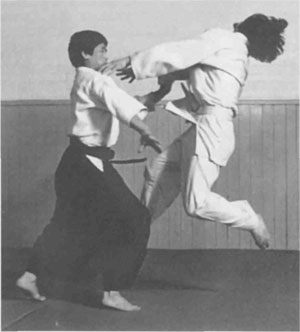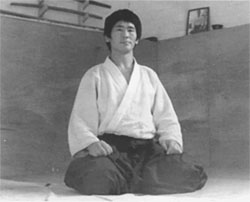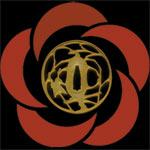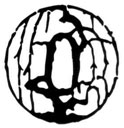 |
Thirty years of Ryushinkan// Источник: B.A.F. Newsletter, Май 2004, No 47
Here Birge S0rensen from Norway and Peter Goldsbury (now a professor at Hiroshima University) recall the early days of the Ryushinkan Dojo. Ryushinkan: autumn 1976 - spring 1977
|
||||||
 Kanetsuka Sensei executing a dynamic Kokyu-nage with Birge Sorensen as uke.
|
Everyone knows that grading is a challenge, and grading at Ryushikan was at that period not an exception. On one occasion Kanetsuka Sensei half way into a lunch-time class stopped the practice and announced time for grading. Everyone was terrified: who was to be graded? No preparations had been made and we were only a few students present. We were all lined up for torifune, shikko, and ukemi, followed by a demonstration of basic principles and throws. Some of us were told to stop and sit in seiza and watch while the examination went on and on and on and on. Twenty minutes after the class should have finished Sensei finally shouted "Yame!" and said to those still on the tatami "Please come for the evening class: we have to continue - there is more to do!" Bathed in perspiration my fellow students bowed and said "Hai!"
Photo session
The James Bond film director Mike Wilson had agreed with Kanetsuka Sensei to take some pictures during an evening class some time. This event had been announced several times, so when it finally turned out to be a reality in late winter 1977, we were quite excited and Sensei was clearly very pleased. So my fellow students and I were told to arrive at 5.30pm - one hour earlier than normal and start warming up. Sensei arrived on time and the class went on at a normal or a slightly elevated pace, going through the techniques (ikkyo, nikyo, sankyo, etc.), all sorts of throwing techniques and a range of henka-waza from these. Later on we moved to weapon techniques using tanto, bokken and jo and combinations of these. Some of these we were familiar with, others were totally new to us.
It must have been obvious that the warming up for 5 hours (!) had made some impact on us. At least Mike Wilson asked us more or less immediately to calm down and relax. These were the most wonderful words that could have been said: at that point we felt we had emptied our glycogen and water reserves completely; and at least one of us in addition his food reserves.
Even though it was by now quite late in the evening (and there was no beer!) we were fascinated by the professional step by step method that Mr Wilson applied to extract and highlight the key movements of Aikido.
Early days at Ryushinkan
by Peter Goldsbury
I became a regular member of Ryushinkan around 1975, on becoming a full-time Ph.D. student at nearby University College London, where I also became a member of the UCL club. At this point in my aikido career, I had had a number of teachers and I was trying to organize my training experiences and perceptions of aikido into a general psycho-physical framework, within which I could relate all these miscellaneous experiences from different teachers. However, I had not had the chance to stay long enough in any particular place to make sure that the framework was solid and built on good foundations. Even after over 20 years training in Japan, I am certain that the five years I spent at Ryushinkan gave me this necessary framework and I have Kanetsuka Sensei to thank for this.
I had met Minoru Kanetsuka Sensei some years before at the Aikikai of Great Britain (AGB) dojo in Chiswick. During the period I was in the US, Chiba Sensei had returned to Japan and Kanetsuka Sensei was now the Technical Director of what had become the B.A.F.. Of course, problems arose with this change of role, but we Ryushinkan students were always aware that our dojo was Sensei's base, his home dojo, his aikido laboratory, where he honed his techniques and teaching methodology.
Ryushinkan classes were held on the second floor of the Albany Street judo dojo. Some names still come to mind from this time: bearded Barry, also training at University College, Marian, who later became his wife, 'tall' Roger, Francis (also doing tai-chi), Ross, an Iranian yudansha who liked to use me as his uke, Nigel, who liked to attack 'really hard', Eric the taxi driver, Doreen, who was in the police force, the Helsby brothers, and, of course, Birge, Bjorn-Erik and Kare from Norway. I think we met pretty well at every practice and, of course, continued the encounters in the pub, just across from the dojo. We became a very tight, close-knit group and thus experienced the joys, and the sorrows - also very important - of training together. I think for those of us who were regular members who trained daily, the experience could be imagined to be close to that of the Hombu uchi-deshi we had heard about.
The dojo was compact and there was a makiwara placed near the edge of the tatami, just as you entered. In the evenings the first class was always basic, usually starting with suwari-waza shomen-uchi ikkyo, but in the second class the makiwara was sometimes used for suburi practice, with Kanetsuka Sensei on one side, maintaining the pace, and students on the other, trying to keep up. During my time at Ryushinkan I started to teach classes and had to use the dojo diary. Every technique taught had to go in the diary, together with comments on the ease or difficulty of teaching it. This was very good pedagogical training.
There are many highlights of the time I spent training in Ryushinkan:
• The za-zen sessions on Saturday mornings led by Mr Fukuda and usually followed by weapons training. These classes were usually taught by the Japanese deshi Katsuki or Tanaka-san and were inevitably followed by huge, delicious, but totally unhealthy breakfasts at some really greasy spoon cafe near Tottenham Court Road tube station, where Katsuki and Tanaka-san would wolf down huge platefuls of fried eggs, bacon, mushrooms, etc etc.
• The trips to weekend courses. These usually followed the Saturday training, minus the breakfasts, and the means of transport was the UCL minibus, which was very basic, but very cheap. Michael O'Callaghan and myself were the only people licensed to drive this 18-seater Ford Transit and it usually fell to me to drive there, train, and then drive back-from places like Birmingham, Newcastle or Liverpool. I remember once becoming awake while driving back on the Ml in falling sleet, and this was partly because everyone else had fallen asleep and I was the only one supposedly awake. We stopped and someone was deputed to keep talking all the way back to London. I think it was Marian who did this.
• The karate class taught by Kanazawa Hirokazu Sensei, who was Kanetsuka Sensei's senior at Takushoku University. At this time we occasionally practised techniques against kicks, and who better to teach kicks than a karate shihan?
• The year in England spent by Sekiya Sensei, who opened another world of aikido to us. This is in no way meant to diminish what we learned from Kanetsuka Sensei. I have learned from living in Japan that aikido is basically a solitary activity. It is the student who has the most responsibility for learning aikido, not the teacher for teaching (though this, too is crucial), but in the year that Sekiya Sensei spent in England, we were introduced to a whole new way of looking at aikido. This actually turned out to be a reinforcement of the basics we had been taught, but leavened with practice of swordwork based on Kashima Shin-ryu.
Since I left England in 1980, I have not had the chance to repeat the intense experiences I had in Ryushinkan (but I very much enjoyed meeting Birge in Stockholm in 2002 and indulging in some nostalgia). In any case, Kanetsuka Sensei has changed, Ryushinkan has changed, I have changed. Nevertheless, aikido training always has a strong historical dimension: it is never purely the learning of technique, but of learning technique from someone, who shows the technique in a certain way at a certain time - and the same technique another way at another time.
I am very happy to congratulate Kanetsuka Sensei and Ryushinkan on its thirtieth birthday. Ad multos annos!
 Kanetsuka Sensei in the Ryushinkan Dojo in 1977.
|
| © Рюсинкан.ру |

 It was Chiba Sensei, the Technical Director of the Aikikai of Great Britain (later to be named the British Aikido Federation) from its establishment in 1968 until 1976, who encouraged Kanetsuka Sensei to open his own dojo in London and suggested the name of Ryushinkan. Ryushin means 'flowing mind'. So in 1973 Kanetsuka Sensei opened his dojo in Albany Street, near Regents Park, in the premises of the celebrated Renshuden judo dojo.
It was Chiba Sensei, the Technical Director of the Aikikai of Great Britain (later to be named the British Aikido Federation) from its establishment in 1968 until 1976, who encouraged Kanetsuka Sensei to open his own dojo in London and suggested the name of Ryushinkan. Ryushin means 'flowing mind'. So in 1973 Kanetsuka Sensei opened his dojo in Albany Street, near Regents Park, in the premises of the celebrated Renshuden judo dojo.